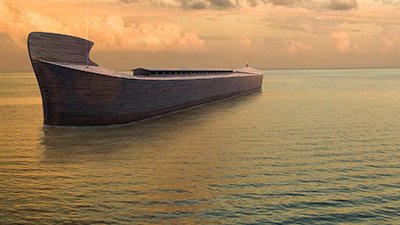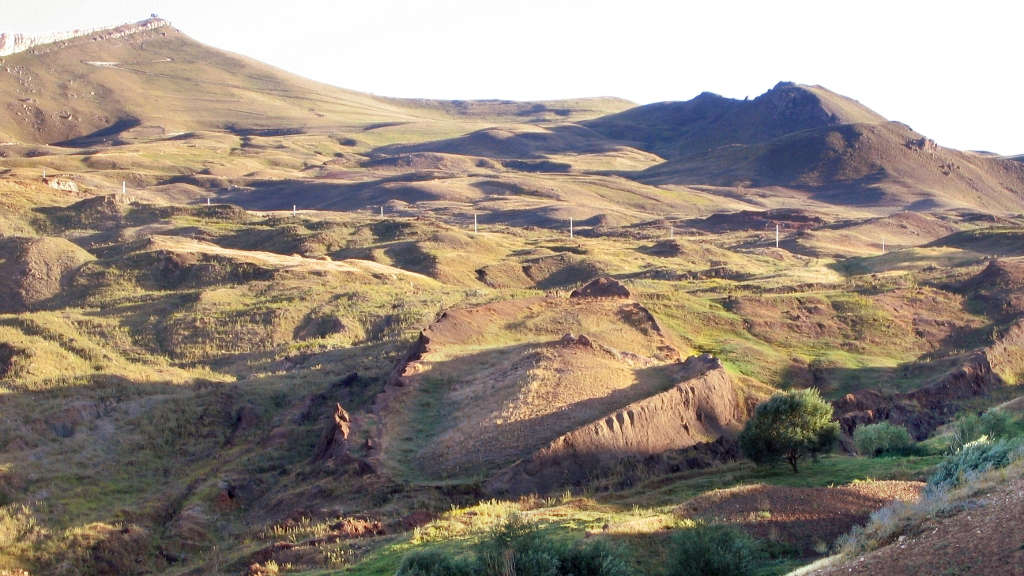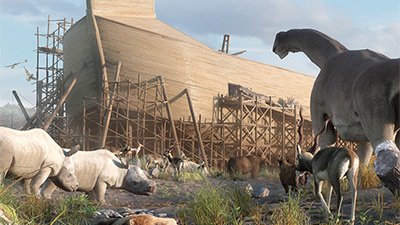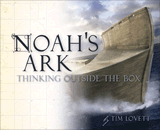Bill Nye the Straw Man Guy and Noah’s Ark
Bill Nye frequently employed straw man arguments throughout the debate. Perhaps nowhere were these fallacies used more often than when he spoke about Noah, the Ark, and the Flood.
Much has been written about the recent debate between Bill Nye and Ken Ham. Multiple articles, and even an entire book, could be written to explain the various issues discussed during the event. The purpose of this article is to focus on some of the many misrepresentations put forth by Bill Nye related to the Genesis account of Noah, the Ark, and the Flood. The Ark Encounter project, which has now received the necessary funding to launch Phase One, will counter these falsehoods and many more. This amazing theme park will also teach people the true history of our planet, particularly about Noah’s Ark, which demonstrated God’s amazing mercy, and the catastrophic Flood that reminds us of God’s judgment against sin. The notion of judgment is one of the reasons secularists like Mr. Nye mock Noah’s Ark and the Flood.
A straw man is a common logical fallacy that occurs when a person misrepresents his opponent’s position. The straw man is constructed to look and sound like the opponent’s position, especially to those who are unfamiliar with the views. The straw man is then easily knocked over, giving the illusion that the opponent’s view has been dismantled. Yet the other person’s actual position was never discussed.
Bill Nye frequently employed straw man arguments throughout the debate. Perhaps nowhere were these fallacies used more often than when he spoke about Noah, the Ark, and the Flood. These misrepresentations may have been intentional, or they may have been the result of Mr. Nye’s ignorance of biblical teaching. Whichever the case, they are largely inexcusable since it is the responsibility of a debater to understand his opponent’s position and deal honestly with it during the debate. The views of Answers in Genesis concerning Noah, the Ark, and the Flood are easily found on our website, so it would not have been difficult for Mr. Nye to discover our actual positions on these matters. What is truly sad is that Mr. Nye, and millions of others, have rejected God and His Word, but often they don’t truly even understand what it is they are rejecting.
Approximately 14,000 Animals on the Ark
In his 30-minute presentation, Mr. Nye attacked the authenticity of the Ark and Flood account in Scripture. One of his points was that there would be no way for Noah and his family to house and care for 14,000 animals on the Ark. There are multiple problems with Nye’s claim.
First, the amount of animals is highly overstated. This mistake is somewhat excusable since an earlier study done by Dr. John Woodmorappe, using inflated numbers to make the “crowded-Ark” problem more challenging, placed the number of animals at around 16,000.1 So Mr. Nye may have based his claim on that study. We don’t know precisely how many animals were on the Ark, but over the past few years, we have been involved in research that leads us to believe the Ark had fewer than 7,000 animals. This information has been on our website for a while, so Mr. Nye did not use the latest information available to him.
Second, he implied that the space available for the animals was highly inadequate on the Ark. He used the National Zoo in Washington DC for a comparison. He said that this zoo has 400 species of animals in 163 acres. The main problem with this argument is that Noah’s Ark was built for survival purposes in an extreme emergency. It was not built so that the animals could live their entire lives in captivity in relatively comfortable conditions. Consider that a family of five can live comfortably in a 1,500 square foot house, but if there were an emergency that caused them to take in other families, it is not unreasonable to think that 20 people or more could survive in that house for a year. It may not be comfortable or ideal, but it is survivable. So Mr. Nye’s comparison to the National Zoo is another irrelevant argument.
Eight Unskilled People
Mr. Nye asked if it is reasonable that “eight unskilled people, men and their wives, were able to do” what “the best ship builders in the world couldn’t do.” Before looking at Nye’s complaints about the Ark, we need to address two straw men built into this statement.
Where does the Bible ever state that just eight people built the Ark?
First, where does the Bible ever state that just eight people built the Ark? Only eight people were on the Ark and survived the Flood, but this doesn’t mean these were the only people involved in building the structure. Actually, the Bible only mentions Noah as building the Ark (Genesis 6:22; Hebrews 11:7), but this doesn’t preclude the possibility of his family members and others helping with the project. Noah may have hired a construction crew, which is how we have depicted the building of the Ark at the Creation Museum.
Second, why should we assume that Noah was unskilled in shipbuilding? Moments earlier in his presentation, Mr. Nye stated that “these people were unskilled [and] as far as anybody knows they never built a wooden ship before.” How does Mr. Nye know that they were unskilled or that they had never built a wooden ship? How could anyone know this? Why make such an assumption? The pre-Flood world was destroyed so other than the brief details provided in Scripture, we really can’t be sure what they were capable of building.
The Bible doesn’t imply that Noah was unskilled. While we don’t know what his occupation was, we do know that he was competent to build the Ark. Who knows? Perhaps Noah was already a shipbuilder prior to building the Ark. Or as mentioned above, he may have hired a skilled construction crew to build it for him.
We have addressed this point on numerous occasions over the years, so there is little excuse for him to be unaware of these details. Once again, we see that Mr. Nye resorted to less-than-honest tactics in an attempt to score points in a debate. But true debate can only really occur when there is an open and respectful exchange of ideas rather than repeated misrepresentations of an opponent’s position.
Large Wooden Boats Cannot Survive
One of Mr. Nye’s major points of contention regarding the Ark and the Flood is the feasibility of constructing a wooden vessel of such magnitude that could remain afloat in the sea. He cited the example of the Wyoming, a 330-foot long (450 feet overall) wooden schooner in an attempt to mock the biblical account.
People in the early 1900s built an extraordinarily large wooden ship, the Wyoming. It was a six-masted schooner, the largest ever built. . . . It would twist in the sea. It would twist this way, this way, and this way. And in all that twisting it leaked; it leaked like crazy. The crew could not keep the ship dry and indeed it eventually foundered and sank; loss of all 14 hands. So there were 14 crewmen aboard a ship built by very, very skilled shipwrights in New England. These guys were the best in the world at wooden ship building and they couldn’t build a boat as big as the Ark is claimed to have been. Is that reasonable? Is that possible that the best shipbuilders in the world couldn’t do what eight unskilled people, men and their wives, were able to do?
While there are similarities between the Ark and the Wyoming, such as overall size and construction material, there are several problems with Mr. Nye’s comparison. For example, the purpose of the Ark was to preserve life by remaining afloat, while the Wyoming and other ships like it were built to transfer cargo, such as coal, from one place to another. In a feedback article on large wooden ships, Tim Lovett pointed out that vessels like the Wyoming were “commercial workhorses built as quickly as possible and with an expected working life of only 12–15 years or as little as ten.”
The greatest problem with the comparison is that Mr. Nye neglected to mention that although it leaked, the Wyoming remained in service for 14 years. Noah’s Ark only needed to float for a maximum of five months before it came to rest on the mountains of Ararat: the Flood began on the seventeenth day of the second month of Noah’s six hundredth year (Genesis 7:11), and the Ark came to rest on the seventeenth day of the seventh month (Genesis 8:4).2
So if a large wooden ship like the Wyoming could function for 14 years, is it really unbelievable or unreasonable to think that the Ark floated for less than half a year? Furthermore, the Wyoming was built on technology largely developed in the age of exploration, which wasn't necessarily all that impressive for wooden ships. Many ships of antiquity had much better design, woodworking, and planking styles as evidenced from ancient records and from those that have been recovered from the sea. Essentially, by the age of exploration, people had lost some of the technology to build reliable and durable large ships.
Conclusion
In his second five-minute rebuttal period, Bill Nye strung these straw man arguments together again.
Then as far as Noah being an extraordinary shipwright, I’m very skeptical. The shipwrights, my ancestors, the Nye family in New England, spent their whole life learning to make ships. I mean, it’s very reasonable perhaps to you that Noah had super powers and was able to build this extraordinary craft with seven family members. But to me it’s just not reasonable.
Mr. Nye repeatedly made the claim that certain events in the Bible, such as the world being created approximately 6,000 years ago and a worldwide Flood, were simply not reasonable.
With all due respect to Mr. Nye, a reasonable man should desire to deal with the truth and to accurately represent his opponent’s position. A reasonable man should strive to think logically, since logic focuses on sound reasoning. It is unreasonable to repeatedly resort to straw man arguments to make your point. If Mr. Nye did this out of ignorance of our position, then he demonstrates his unreasonableness by mocking and rejecting views that he doesn’t even comprehend. These are the actions of an unreasonable man.
It is our hope that Mr. Nye and other skeptics out there would take the time to carefully study the answers we have provided to their skeptical questions. Even more importantly, we pray that they would turn from their sin and place their faith in their Creator, Jesus Christ. Only then will they have a rational basis for doing science and believing in things like morality and logic. Only then will they truly understand just how reasonable the Christian faith really is. What sounds like foolishness to the skeptic is true wisdom from the Creator Himself (1 Corinthians 1:20–31).
Footnotes
- He stated that if kind were equivalent to the family level, then there would have been about 2,000 animals on the Ark. “However, in order to make this exercise more interesting, I have deliberately made the problem of animal housing on the Ark much more difficult by adopting the genus as the taxonomic rank of the created kind.” John Woodmorappe, Noah’s Ark: A Feasibility Study (Santee, CA: Institute for Creation Research, 1996), 7.
- See Bodie Hodge, “Biblical Overview of the Flood Timeline.” Answers in Genesis, last accessed February 28, 2014, http://www.answersingenesis.org/articles/2010/08/23/overview-flood-timeline.
Recommended Resources

Answers in Genesis is an apologetics ministry, dedicated to helping Christians defend their faith and proclaim the good news of Jesus Christ.
- Customer Service 800.778.3390
- Available Monday–Friday | 9 AM–5 PM ET
- © 2026 Answers in Genesis





